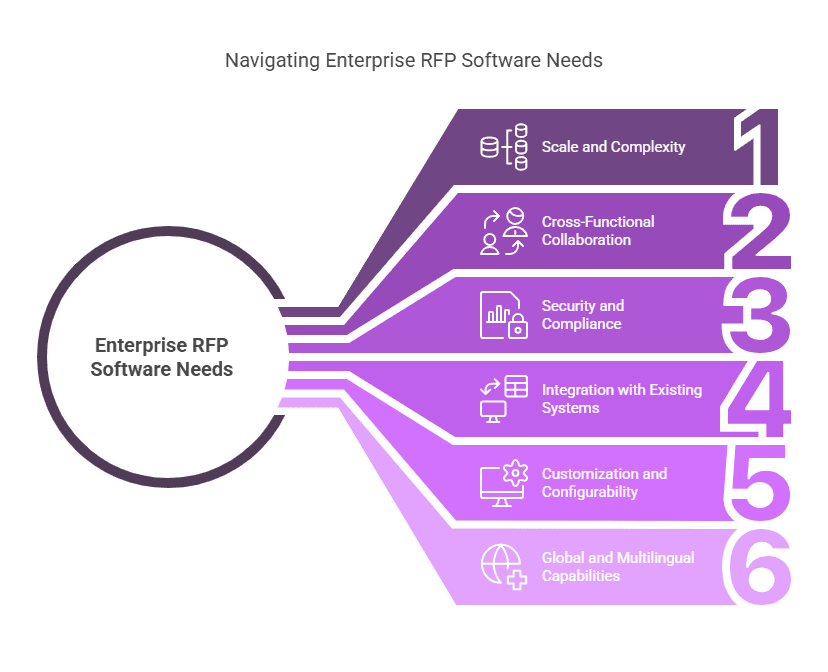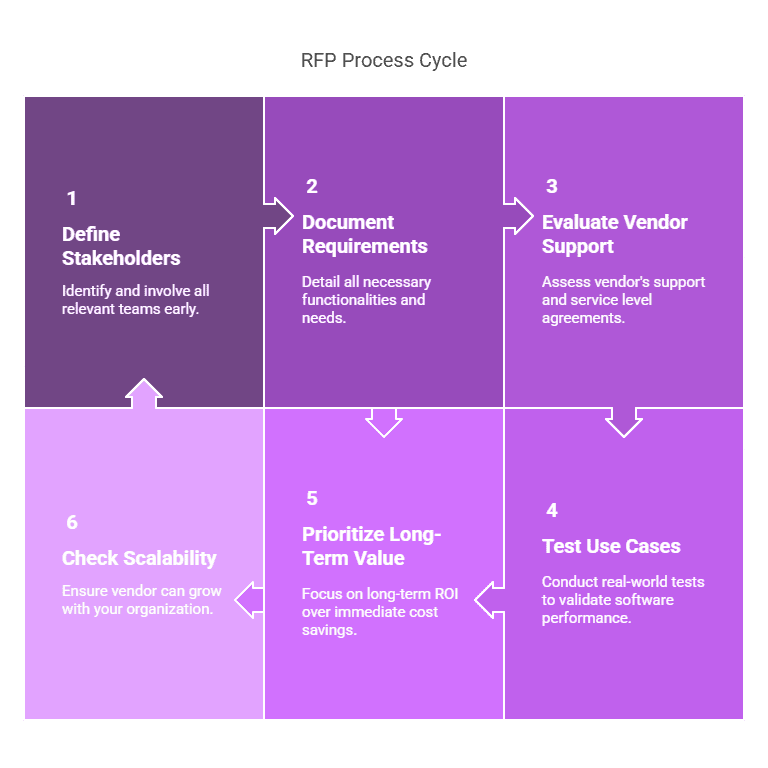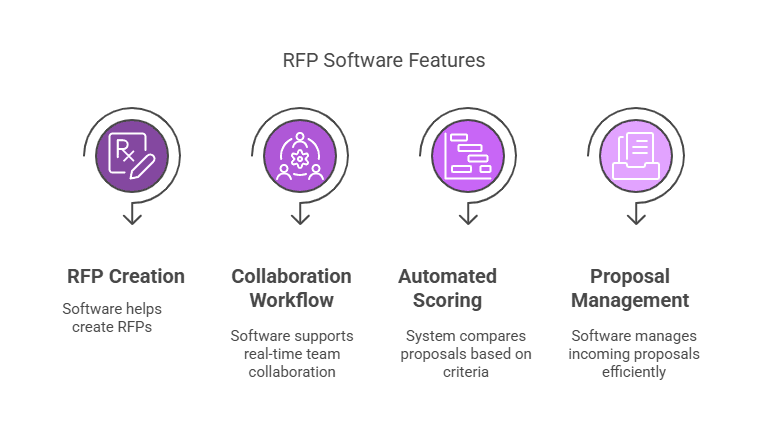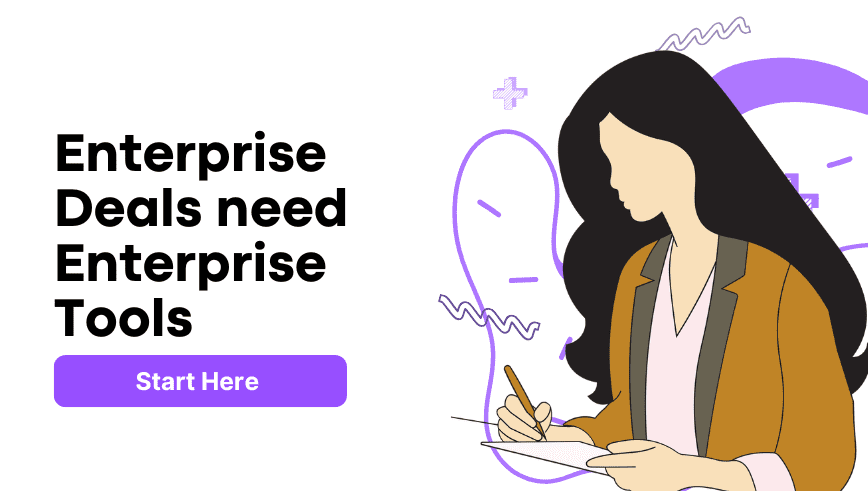Choosing the right Request for Proposal (RFP) software is a critical decision for any organization, but when it comes to enterprise-level businesses, the stakes—and the complexities—are much higher.
While small and medium-sized companies might prioritize ease of use or affordability, enterprises need to consider scalability, integration, security, governance, and cross-functional collaboration on a whole other level.
Here’s a breakdown of what sets the enterprise RFP software selection process apart—and how to navigate it strategically.
Why Choosing RFP Software is Different for Enterprises

1. Scale and Complexity
Enterprise organizations often manage dozens—or even hundreds—of RFPs across departments, regions, and business units.
Unlike small and mid-size companies that might issue a handful of RFPs per year, enterprises require a platform that can handle massive data volumes, parallel projects, and a wide range of stakeholders.
Features like advanced search, document management, automated workflows, and project templates become essential.
2. Cross-Functional Collaboration
Enterprise RFPs usually involve multiple departments: procurement, legal, finance, compliance, IT, and the actual business unit making the purchase.
This level of collaboration demands software that allows for user roles, version control, commenting, and secure collaboration without introducing friction.
Read our article on Comment améliorer la collaboration sur les appels d'offres entre les équipes.
3. Security and Compliance Requirements
Larger organizations must comply with stricter security protocols, industry regulations, and data governance standards.
RFP software must support role-based access control, single sign-on (SSO), audit trails, encryption, and possibly adhere to standards like SOC 2, GDPR, HIPAA, or FedRAMP.
4. Integration with Existing Systems
Enterprises typically operate in complex IT environments with ERP, CRM, contract management, procurement, and document storage systems.
RFP software must integrate smoothly with these tools—like Salesforce, SAP, Workday, or Microsoft Dynamics—so that teams can pull and push data without duplicating effort or compromising accuracy.
5. Customization and Configurability
Off-the-shelf solutions often fall short when it comes to the unique workflows and approval chains within an enterprise.
RFP platforms must offer deep customization—custom fields, templates, approval paths, and dashboards—to fit the organization’s procurement strategy and internal processes.
6. Global and Multilingual Capabilities
Multinational companies may require support for multiple currencies, tax regimes, time zones, and languages.
Enterprise-grade RFP software often supports global operations with localized configurations and multilingual user interfaces.
How Enterprises Should Approach RFP Software Selection

1. Define Stakeholders Early
Identify every team that will touch or rely on the RFP process—from procurement to legal to compliance—and bring them into the selection process early. This helps uncover requirements you might otherwise miss and boosts buy-in.
2. Document Your Requirements in Detail
Go beyond basic functionality. Think about:
- Workflow customization
- User permission levels
- Audit and reporting needs
- Integration requirements
- Security certifications
- Analytics and KPI dashboards
3. Evaluate Vendor Support and SLAs
For enterprise clients, vendor support isn’t just a nice-to-have. Look for providers that offer:
- Dedicated account managers
- 24/7 enterprise support
- Onboarding and training
- SLA-backed uptime and response guarantees
4. Test with Real-World Use Cases
Don’t just rely on demos. Run actual use cases during your trial or proof-of-concept phase. Test how the software handles a real RFP, includes reviewers, scores responses, and integrates with other systems.
5. Prioritize Long-Term Value Over Price
While cost always matters, enterprise software decisions are more about long-term ROI than short-term savings. Consider total cost of ownership (TCO), including:
- Implementation and setup
- Training and onboarding
- Licensing and user fees
- Support and upgrades
6. Check Vendor Scalability and Roadmap
Is the RFP software vendor prepared to grow with your organization? Explore their product roadmap, investment in R&D, and vision for future features that align with where your business is headed.
Enterprise RFP Software Selection Evaluation Template
1. Functional Requirements
- RFP Creation and Management
- Can the software create RFPs from templates or scratch?
- Does it support customization for specific requirements?
Can you include sections such as timelines, evaluation criteria, and deliverables?
- Collaboration and Workflow
- Does it allow multiple users to collaborate in real-time?
- Can you assign tasks, deadlines, and approvals to team members?
- Does it support comment and feedback functionality within documents?
- Automated Scoring and Evaluation
- Does it have a built-in evaluation scoring system?
- Can the system compare and rank proposals based on weighted criteria?
- Proposal Management
- Does it help manage incoming proposals and ensure they are submitted on time?
- Can you track the status of each submission?
- Does it allow for version control of proposals?

2. Usability
- User Interface (UI)
- Is the interface intuitive and user-friendly?
- Can users easily navigate through different features?
- Customization and Flexibility
- Can you customize templates, reports, and workflows to fit your business needs?
- Does the software adapt to your company’s processes or require significant adjustments?
3. Integration and Compatibility
- CRM and ERP Integration
- Does it integrate with your CRM and ERP systems (e.g., Salesforce, SAP)?
- Is data automatically synchronized between systems?
- Third-Party Tools and Platforms
- Can the software integrate with other tools like document management systems or electronic signature platforms?
- Data Import/Export
- Can you import/export data easily from other tools or formats (e.g., CSV, Excel)?
4. Security and Compliance
- Data Security
- Does the software comply with industry-standard security protocols (e.g., encryption, two-factor authentication)?
- Is data stored in a secure environment, and does it have access controls?
- Compliance
- Does the software support compliance with relevant standards (e.g., GDPR, SOC 2)?
- Can it help manage audit trails for transparency?
5. Reporting and Analytics
- Custom Reports
- Can you create customized reports based on various parameters (e.g., vendor performance, evaluation scores)?
- Is there a dashboard for tracking key metrics and RFP activity?
- Data Visualization
- Does the software offer data visualization tools (e.g., graphs, charts)?
- Can reports be easily shared with stakeholders?
6. Vendor Support and Training
- Customer Support
- What support channels are available (e.g., chat, email, phone)?
- Is support available during your working hours or 24/7?
- Documentation and Training Resources
- Are comprehensive user manuals, FAQs, or video tutorials available?
- Does the vendor provide training sessions or onboarding support?
7. Pricing and ROI
- Cost Structure
- What is the pricing model (e.g., subscription-based, one-time fee)?
- Are there any hidden costs or additional fees (e.g., for upgrades, integrations)?
- Value for Money
- Does the software offer the features and functionality that justify the price?
- Will it save time and improve efficiencies in your RFP process?
8. Vendor Reputation and Reviews
- Market Reputation
- What is the vendor’s reputation in the market (e.g., reviews, case studies)?
- Have other enterprises successfully used this software for RFP management?
- Product Updates and Roadmap
- Does the vendor regularly update the software with new features and enhancements?
- Is there a clear product roadmap that aligns with your future needs?
Réflexions finales
The RFP process is inherently complex for enterprises—so the software you choose should reduce that complexity, not add to it.
Look for platforms built for scale, collaboration, and compliance, and involve your stakeholders throughout the decision-making process.
Unlike smaller businesses, the cost of a misstep for enterprise procurement is measured in wasted time, compliance risks, and lost opportunities.
Choosing the right enterprise RFP software is less about checking boxes and more about future-proofing your procurement strategy.
Make the choice strategically, and your organization will be better positioned to move faster, operate smarter, and spend wiser.
